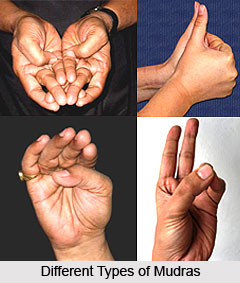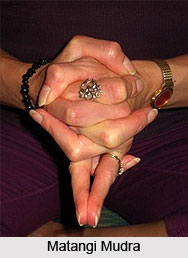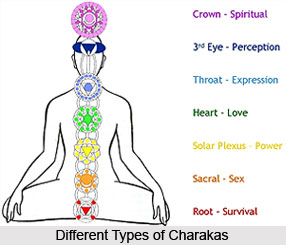 Concept of Mudras is dependent on the ten different fingers of both hands of the human body as every finger of the hand signifies a particular meaning significance and meaning. The appropriate utility of the Mudras imparts the unique capability of healing to the Mudras. It is believed that the five elements of air, water, sky, fire and earth are all contained in the fingers, in predetermined proportions and even a slight misbalance in their proportions might prove fatal for the lives of people. Bringing about the proper balance in these elements is a complicated task and therefore the accurate Mudra must be practised in order to coordinate and blend them properly in the human body. Mudras are the art of finger tips and the tips are considered to be the area of concentrated energy.
Concept of Mudras is dependent on the ten different fingers of both hands of the human body as every finger of the hand signifies a particular meaning significance and meaning. The appropriate utility of the Mudras imparts the unique capability of healing to the Mudras. It is believed that the five elements of air, water, sky, fire and earth are all contained in the fingers, in predetermined proportions and even a slight misbalance in their proportions might prove fatal for the lives of people. Bringing about the proper balance in these elements is a complicated task and therefore the accurate Mudra must be practised in order to coordinate and blend them properly in the human body. Mudras are the art of finger tips and the tips are considered to be the area of concentrated energy.
History of Concept of Mudras
In the long gone days in ancient India, the Hindus tried out every type of body positions, meditations, fasting, in a pursuit for the ultimate yoga of self-development. One of the bequests of these experiments was the development of the concept of Mudras that worked on the body and the mind in almost the same manner to what yoga would do. That was just the beginning of the enormous concept of Mudras. Hindu mythological beliefs state that the idea of Mudras was first conceptualised by the Hindu God, Lord Shiva. The concept of Mudras is popular in art, dance and also in `Tantra`. It is said to be a great mark of identification of Bodhisattvas, Buddha and other forms of deities.
 In the Sanskrit language, Mudra refers to `seal` which is a traditional gesture which can be traced back to ancient periods, practised in Hinduism and also Buddhism. Mudras generally are performed with the aide of the entire human body, utilizing fingers and hands. The `seal of authenticity`, which is very specific to Indian religions is employed by Mudra. Various Eastern ideologies have asserted about the important of Mudras in Indian culture as well as an integral part of Yoga.
In the Sanskrit language, Mudra refers to `seal` which is a traditional gesture which can be traced back to ancient periods, practised in Hinduism and also Buddhism. Mudras generally are performed with the aide of the entire human body, utilizing fingers and hands. The `seal of authenticity`, which is very specific to Indian religions is employed by Mudra. Various Eastern ideologies have asserted about the important of Mudras in Indian culture as well as an integral part of Yoga.
How Mudras Work
The thumb portrays the earth element which is associated with the stomach and worry while large intestines and lungs are controlled by the index finger which has an impact on emotions of depression and anxiety. The middle finger of the hand is connected with the heart, respiratory and circulatory systems, small intestine and also the heart and its emotions are hastiness and impatience. The ring finger is associated with the nervous system, liver and gall bladder and represents wood and the little finger portrays fear.
Benefits of Mudras
Practising Mudras possesses several benefits as asserted by the sciences of Mudras. The `nadis` which provide nutrition to the internal human organs are enabled to function properly, by balancing the flow of energy through them by the Mudras. People performing Mudras are often said to have experienced an upsurge of positive energy by getting rid of negative thoughts and feelings. A combination of meditation and Mudras is capable of introducing a marked alteration inside the human mind, as revealed by studies. Mudras are also believed to arouse the `Kundalini energy` of the body and must be performed either prior to practising Yoga like Asanas` or `pranayama`.
 The different learning of astrology and palmistry connotes different meanings and are of immense importance in the specific scientific learning. Communication is linked to the little finger and it is also connected to the second `Chakra`. The middle finger is related to the planet Saturn and signifies the `Throat Chakra` and it denotes responsibility. The ring finger is connected to Apollo and is connected to the `Root Chakra` while the index finger is associated with Jupiter. The index finger refers to self-worth and has the association with the heart chakra. Self-assertion is represented by the thumb and is associated with the fire element.
The different learning of astrology and palmistry connotes different meanings and are of immense importance in the specific scientific learning. Communication is linked to the little finger and it is also connected to the second `Chakra`. The middle finger is related to the planet Saturn and signifies the `Throat Chakra` and it denotes responsibility. The ring finger is connected to Apollo and is connected to the `Root Chakra` while the index finger is associated with Jupiter. The index finger refers to self-worth and has the association with the heart chakra. Self-assertion is represented by the thumb and is associated with the fire element.
With its pregnant past and copious tradition, the concept of Mudra has time and time again been used in the traditional medicine and even in the application of acupuncture. The finger tips in Mudra science are used to release and gain energies and soothe the body and mind by applying many techniques of medicine.




















